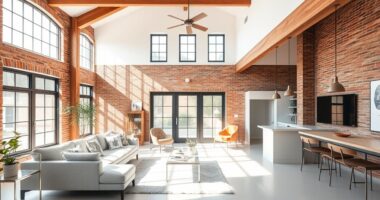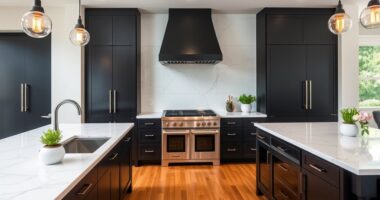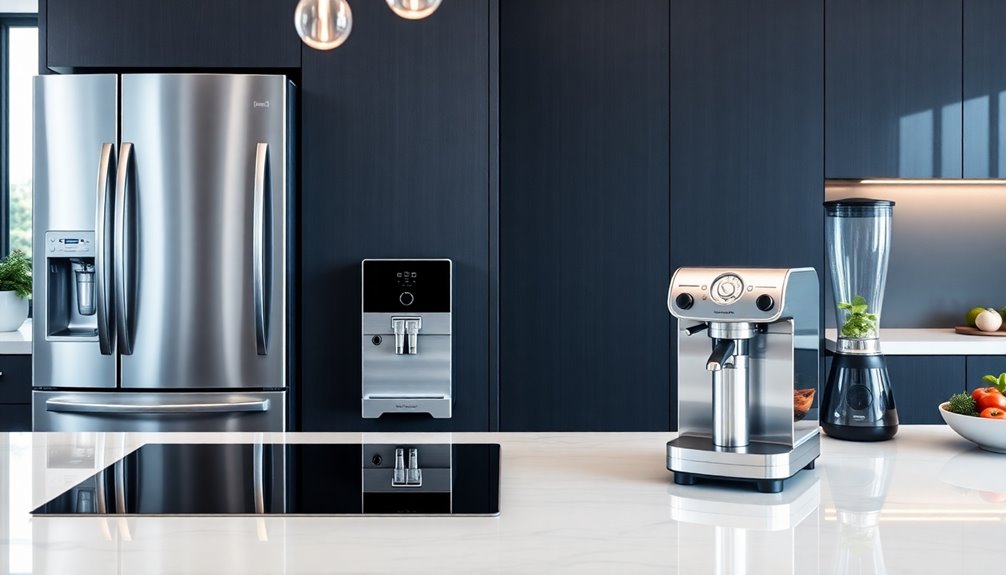Before you remodel, set clear goals and a realistic budget, including a buffer for surprises. Prioritize what you need versus what you want to maximize your investment. Choosing the right contractor is essential; always verify their credentials and get multiple quotes to guarantee you're getting the best deal. Invest in quality materials that enhance durability and energy efficiency, potentially increasing your home's value. Finally, think about space efficiency—opt for a layout that improves flow and functionality. Stick around to discover more game-changing tips that can make your remodel a success!
Key Takeaways
- Clearly define your renovation goals to prioritize essential improvements and maximize return on investment.
- Establish a realistic budget, including an extra 10-20% for unexpected expenses during the remodeling process.
- Choose high-quality, durable materials that enhance functionality and can increase your property's resale value.
- Evaluate your space for efficiency, considering open layouts and multi-functional furniture to improve usability.
- Consult with experienced contractors to align your vision, ensure transparency, and receive valuable insights on feasibility and timelines.
Define Your Goals and Budget

When starting on a remodeling project, it's vital to clearly define your goals and budget upfront. This step sets the foundation for a successful home remodeling journey.
First, think about what you want to achieve—are you looking to increase your property's value or enhance your living space's functionality? Knowing this helps you prioritize renovations effectively.
Next, establish a realistic budget. Experts recommend adding an extra 10-20% to account for unexpected expenses that often arise during the remodeling process. This financial preparedness guarantees you’re not caught off guard by surprises. Additionally, consider the tax implications of significant renovations, as they can affect your overall financial strategy. It’s also important to prioritize your spending and avoid unnecessary expenses. One of the home renovation mistakes to avoid is overspending on trendy or high-end materials that may not add significant value to your home. Another common mistake is not properly researching and vetting contractors, which can lead to subpar work and additional costs in the long run. By carefully planning and budgeting for your renovation, you can avoid these pitfalls and ensure a successful and cost-effective project.
Consider the must-have features versus the nice-to-have elements; this distinction aids in making informed decisions within your financial constraints. By focusing on essential improvements, you can allocate your budget wisely and maximize your return on investment (ROI).
Ultimately, defining your goals and budget will guide not just your spending but also the entire remodeling journey. When you're clear on your objectives and financially prepared, you'll navigate challenges with greater ease and confidence, paving the way for a successful transformation of your home. Additionally, having a clear budget plan is essential for managing income and expenses effectively, ensuring you stay on track throughout the project.
Plan and Prioritize Effectively

Once you've defined your goals and budget, the next step is to plan and prioritize effectively. Start by creating a thorough list of areas to address in your home renovation.
It's essential to prioritize structural issues before diving into cosmetic upgrades. This guarantees you have a solid foundation for your remodeling project. Additionally, consider evaluating your home's current energy efficiency, as this can influence future design choices and cost savings. Investing in a robust home security system can also enhance safety during your renovation. Furthermore, considering effective ventilation options can significantly improve air quality and comfort in your remodeled space.
Research local regulations and necessary permits ahead of time. Failing to do so can lead to delays and additional costs during your renovation.
Next, consult with experienced contractors to gain insights on budget feasibility and timeline management. They can help guarantee your plans align with practical execution.
Establish a realistic timeline with specific milestones, allowing for flexibility to accommodate any unforeseen issues that may arise. Incorporating natural elements into your design can also help promote tranquility and enhance the overall ambiance of your remodeled space.
It's wise to allocate 10-20% of your budget for unexpected expenses. This cushion minimizes financial strain and helps maintain project continuity throughout the remodeling process.
Choose the Right Contractor

Choosing the right contractor can make or break your remodeling project. Start by verifying contractor credentials; check their licenses, insurance, and references to confirm they're qualified. A solid contractor should have a proven track record with similar projects, as this experience will help navigate the renovation process and guarantee compliance with building codes.
Next, obtain multiple quotes from different contractors. This way, you can compare pricing and services to find the best value for your budget.
While you're at it, discuss the contractor's communication methods and how often you can expect updates. Clear expectations are key to a smooth project.
It's also essential to share detailed plans and goals with your chosen contractor. This alignment helps them understand your vision, making sure the work meets your expectations. Additionally, consider incorporating open floor plans into your design, as they enhance space and flow, contributing to a modern farmhouse aesthetic.
Don't hesitate to ask questions and clarify anything that seems vague.
Invest in Quality Materials

Quality materials are the backbone of any successful remodeling project. When you invest in quality materials, you're not just enhancing the appearance of your home; you're also ensuring durability and longevity. For instance, high-quality granite or quartz countertops in kitchens and bathrooms can greatly reduce maintenance costs over time. Similarly, durable flooring options like hardwood and luxury vinyl plank withstand wear and tear, providing long-term value. Furthermore, incorporating smart toilets as part of your bathroom remodel can enhance both hygiene and comfort, thanks to their advanced cleaning features and heated seats. Additionally, selecting energy-efficient materials, such as insulated windows and high-efficiency appliances, can lead to savings on utility bills, often recouping their initial costs within a few years. Investing in heat pumps for your home can further boost energy efficiency, significantly reducing overall heating and cooling costs. Remember, using quality materials can raise your home's resale value by 10-15%, aligning with local market standards. Furthermore, investing in energy efficiency not only contributes to lower utility bills but also enhances overall comfort in your home. Moreover, integrating air purifiers during your remodel can improve indoor air quality, contributing to a healthier living environment.
Here's a quick visual representation of the benefits:
| Material Type | Benefits | Impact on Home Value |
|---|---|---|
| Granite/Quartz | Durable, low maintenance | Increases resale value |
| Hardwood Flooring | Aesthetic appeal, withstands wear | Adds long-term value |
| Insulated Windows | Enhances energy efficiency | Reduces utility bills |
| High-Efficiency Appliances | Cost-saving over time | Boosts market appeal |
Invest wisely, and your renovation project will pay off in the long run.
Maximize Space Efficiency

After investing in quality materials, the next step in your remodeling journey is to maximize space efficiency in your home.
Start by evaluating your current layout to identify opportunities for open floor plans. This approach creates a more spacious and connected feel, enhancing your quality of life.
Utilize vertical space by installing shelves and cabinets that extend to the ceiling. This maximizes storage solutions without sacrificing precious floor area. Incorporating sustainable materials can also enhance the aesthetic appeal while being mindful of the environment. Consider incorporating natural materials like wood to maintain a warm and inviting atmosphere.
Incorporating built-in furniture, like benches or desks, not only saves space but also adds functional design elements to your home.
When planning your renovations, consider traffic flow. Guarantee clear pathways between frequently used areas, which improves usability and comfort in daily activities.
Additionally, decluttering your living spaces is vital. Organizing and minimizing belongings can greatly boost the overall appeal and functionality of your home. Implementing space optimization techniques can further enhance the efficiency of your remodel.
Frequently Asked Questions
In What Order Should You Do Renovations?
You might think it's best to start with cosmetic updates, but that can lead to wasted effort.
First, tackle structural renovations like roof repairs and foundation work; they're vital for your home's integrity.
Next, update essential systems like plumbing and electrical.
Focus on major spaces like the kitchen and bathroom for a high return on investment.
After that, move to cosmetic updates and finish with outdoor enhancements to boost curb appeal.
What I Wish I Knew Before I Renovated?
You might wish you'd known how essential a clear vision is before starting your renovation.
Setting specific goals can streamline decisions and save you from costly changes. It's also smart to budget an extra 10-20% for unexpected expenses.
Researching high-quality materials pays off in the long run, and maintaining regular communication with your contractors helps keep everyone on the same page.
Finally, think about the functionality of your space for better daily use.
What Is the Hardest Room to Renovate?
Renovating a kitchen is like steering through a maze filled with twisting paths and hidden traps.
You've got plumbing, electrical wiring, and the struggle to harmonize cooking, cleaning, and storage.
Bathrooms aren't much easier; their compact spaces demand creativity and precision.
Both areas require hefty investments, so budgeting's essential.
Is $50,000 Enough to Renovate a House?
Is $50,000 enough to renovate a house? It can be if you're strategic about your choices.
You might focus on key areas like the kitchen and bathrooms, where updates can greatly enhance your home's value.
Consider energy-efficient upgrades too, as they'll save you money long-term.
Prioritize your needs and decide whether to tackle one high-end project or multiple smaller ones to maximize your budget's impact effectively.









